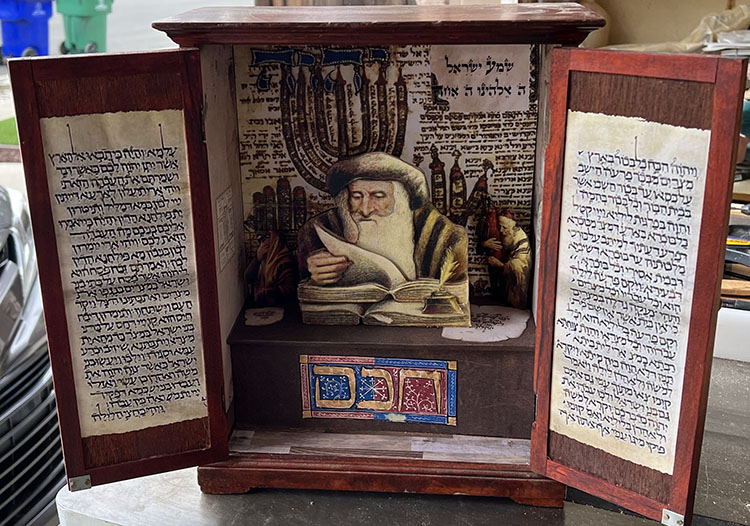
By Donald H. Harrison

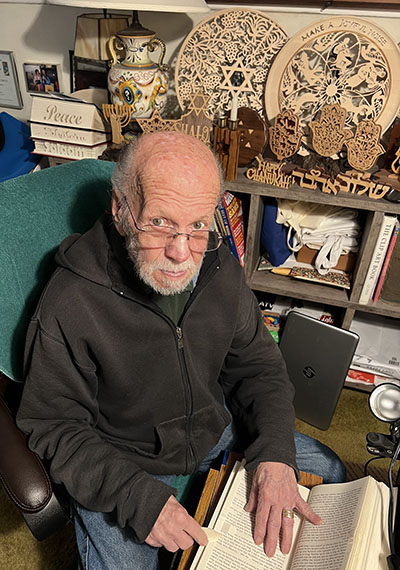
SAN DIEGO – Master woodworker Bill Goldschneider, 86, says of late “99.9 percent of everything I’ve made in whatever medium I have worked has been Jewish-themed.” He has made hamzas: an intricately carved scene of Jerusalem surrounded by the emblems of the 12 biblical tribe; Passover seder plates, and various book-art designs utilizing Hebrew and English calligraphy. He makes Jewish-themed pendant necklaces out of dominoes which he gallantly presents to female visitors.
He has created so much Judaica that he stands ready to exhibit more than 50 pieces if an appropriate venue can be found, such as a synagogue, museum, or a Jewish center. He even has devised special cases in which to transport his creations, so that such an exhibition can be taken on the road.
Goldschneider says his love of crafts started when he was a child living with his parents in a one-bedroom apartment in Philadelphia. “I used to make things out of empty cereal boxes or the cardboard (stiffeners) that came in the shirts,” he recalled.
“I would model off things that I would see,” he said. “For example, at the movie theatre if you put a nickel in the machine and turned the handle, something dropped out. So, I would try to duplicate that out of a cereal box. I would make a candy machine and if you pulled something out, something dropped down. … At a young age, I also had an interest in puppetry. Once when I must have been 10 years old, I made a puppet stage out of a big box that a refrigerator came in.”
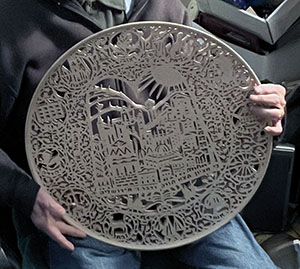
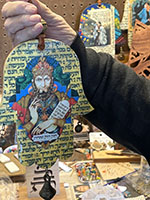
Upon reaching adulthood, Goldschneider joined the Navy and was taught how to be a photographer. He completed his enlistment in San Diego, where he decided to settle down. Initially, he tried to make a living as a studio photographer, but when that didn’t work out, he went to work for the U.S. Postal Service, working his way up during his 31-year-career from a clerk to the manager of logistics and transportation for mail deliveries throughout San Diego County.
As a boy, Goldschneider had taught himself to play a neighbor’s old beat-up guitar and to read music. That self-training came in handy some 40 years ago when he joined the San Diego Mandolin Orchestra, with which he still performs. Add home gardening to Goldschneider’s crafts and music, and you get a glimpse of a man who finds many avenues for his self-expression.
His wife of 51 years, Sharon, has been a major influence on him. A former teacher at Benchley-Weinberger and Kumeyaay Elementary Schools, Sharon shares his love of crafts, having created many varieties of dolls in her spare time. After Goldschneider retired from the post office in 1992, she prompted him to make things for her classroom.
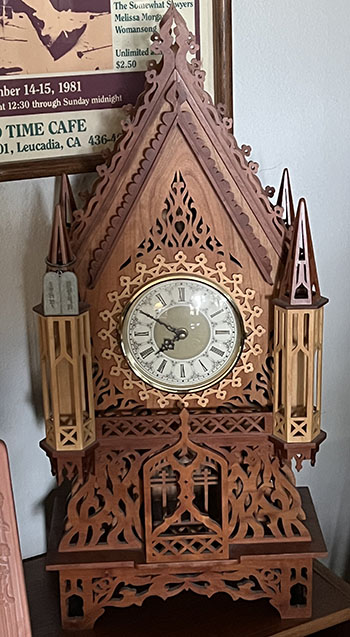
“I started out by making a big cart (6 feet long, 2 feet wide, a few feet high) with wheels on it so that the kids could put their backpacks and jackets in and then they could wheel it into the room,” Goldschneider said. “Other teachers wanted them, so I made a few more. It wasn’t art, but it was woodworking. I painted them and some I decorated.”
“In order to make some of the things for her room, I needed a special tool, a scroll saw – which used to be called a fret saw.” He purchased one at the San Diego County Fair at Del Mar, and for the last 30-odd years Goldschneider has re-created art on wood using the scroll saw, which enables him to cut out intricate patterns.
The Goldschneiders, whose home is filled with crafts and books, at one point owned a bookstore at the beach. Later, Goldschneider became one of the artists in residence at Spanish Village in Balboa Park. “For eight years, I was in a Studio 38 called “Art and Wood” and I sold quite a few of my works—some of my larger wildlife work, but also smaller pieces, things with different motifs that people might buy for $25 or $30,” Goldschneider related. Particularly popular, he said, were “nativity scenes, or anything connected to Christmas, and I was good at it.” He said he felt a little bit like the Jewish music composer Irving Berlin, whose songs “White Christmas: and “Easter Parade” were among his most enduring hits.
Goldschneider was honored in 2017 by the International Wood Society, which promotes sustainable wood and preservation. “Every year they sponsor an exhibition somewhere in the world. When they came to the United States, to Long Beach, California, I was invited to represent scroll sawing. For one whole week at the Long Beach Convention Center, there was a working exhibition with 200 artisans from 62 different countries, all under one roof, working away, and I represented scroll sawing. I was well-received, all expenses paid; they put me up in the Queen Mary. What I did for a whole week, I made chess sets. One was themed for Peter the Great, another one was nautical; every day for five days I made a different chess set.”
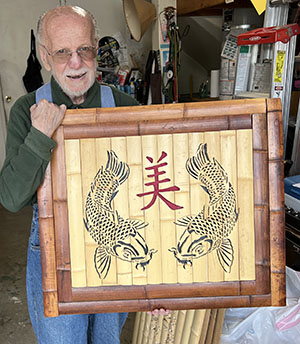
Goldschneider has entered crafts in competitions at the San Diego County Fair every year since 1992, including this year. “Five years ago, I came up with a technique for using bamboo slats as my canvas instead of regular wood, and since then every year I have created another piece with an Asian theme,” he said. This year, he submitted two for the fair. “One is an Asian dancer with flowing robes and the other is a portrait of a young Asian woman.”
In his home office, he has fashioned a small tree from the multicolored ribbons he has won over the years and expects to add to it this year as he already has received an invitation to the fair’s annual awards ceremony.
Sharon challenged him to create Jewish-themed art in which he more or less specializes today. Typically, he will scroll through Jewish sites on the internet, find photos or drawings, then photograph and enlarge them and create on paper a pattern to be laid over the surface of maple, walnut, mahogany or cherry wood, and then, using his beloved scroll saw, transfer that pattern to wood.
For Passover this year, he made three seder plates from wood and “at the same time I was working on a Chanukah menorah that I had to paint,” he said. “The painting (from his own design) was something new for me. That was exciting.”
In addition to his woodwork, he loves book art, in which the pages of a book are folded in precise patterns to create an image between its covers. “Folding books is very detailed; you are talking about 500 pages, so you need a pattern,” he said. “There is a software program where you can make the patterns, but I am not that computer savvy, so what I did was produce the artwork and I would scan it and [send] it to a very nice lady in England. She runs it through the computer program that she has and sometimes the very next day she [returns] the pattern to me and I print it out and she only charges me a couple of bucks. Sometimes if she doesn’t think a pattern will work, she will work on it and correct it, or whatever.”
I asked him if among all the pieces he has made over the years, he has any favorites.
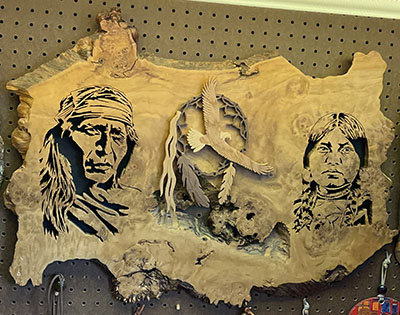
“Three,” he replied promptly. One, which won a blue ribbon at the fair, features the faces of Native Americans and an eagle. Another is an ornate clock. The third is “an old Italian bookstand that you might find in a library. Its design features violins and mandolins. It all folds up and you can put it up to various heights.”
Often when working on such projects, Goldschneider loses track of time. “I am not punching a clock,” he says. “It takes however long it takes. It is all intricate work, very intricate. Some of it takes week, and some pieces I can knock out in a day.”
Although he produces many beautiful objects, Goldschneider does not call himself an artist because he does not originate the artwork which he transforms into wood.
“I always felt that my strong point was recognizing something good that somebody else made and then working with that,” he explained.
*
Donald H. Harrison is editor emeritus of San Diego Jewish World. He may be contacted via donald.harrison@sdjewishworld.com